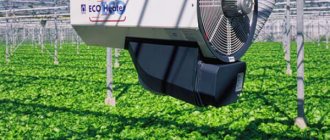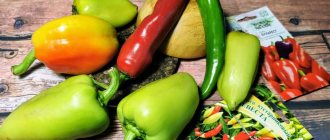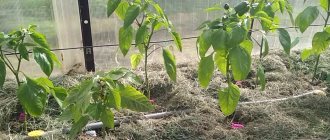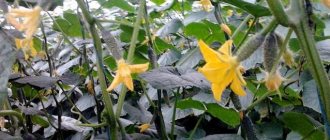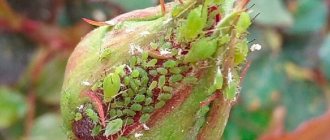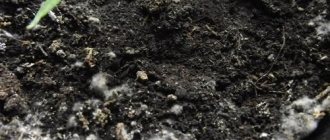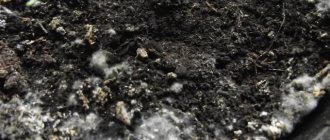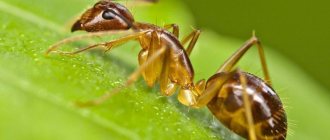Experienced gardeners know that when growing seedlings, and then vegetables, they have to deal with many negative factors. When I noticed a white coating on the ground in the greenhouse, I chose a proven method of dealing with it. But first I had to determine what this phenomenon was and why it appeared, and then develop a strategy for the future.
Source industry60plus.ru
Reasons for appearance
After conversations with familiar greenhouse owners, I found out that a white coating on the soil in a greenhouse is not such a rare occurrence. But the answer to the question of why it appears and how, most importantly, to get rid of it may be different. It turned out that there are two types of white plaque of completely different nature.
White plaque appears as a result of two processes: the development of pathogenic microorganisms or the accumulation of soil salts. Visually distinguishing one from the other is not easy. But you can analyze the greenhouse care system to understand the reason.
Biological cause
Various mold cultures are always present in the soil, but with proper care they do not manifest themselves. Fungus (mold) is activated by the following deviations from care standards:
- Overmoistening of the soil. This can happen when you water excessively by hand over a long period of time, or, for example, if the seal in your drip irrigation system breaks and you don't notice.
Source diy.obi.ru
- Irregular ventilation. Without proper ventilation, the warm and humid microclimate of a greenhouse creates the best conditions for increased mold growth.
- Lack of ultraviolet radiation. When there is little sun, the temperature drops, but the humidity remains the same. This combination also gives impetus to the development of organics.
- Heavy ground. Dense soil is characterized by reduced capillary permeability, which is why moisture does not have time to completely evaporate. Combination with at least one of the previous conditions leads to an obvious result.
Chemical cause
The second reason why the soil in a greenhouse turns white may be the process of podzolization of the soil. In this case, clay and alkaline particles and metal oxides (for example, iron and aluminum) are brought to the surface.
Efflorescence, as a rule, does not harm the plants themselves (if you do not ignore it for too long), but it leads to a decrease in soil fertility, and then the yield. The following reasons can trigger the process:
- Increased acidity levels. Occurs when too much fertilizer is applied or it is chosen incorrectly.
Source ytimg.com
- Crop rotation is formed incorrectly. The key to a high yield is the correct selection of vegetable crops. They should not only be compatible, but also be planted in rotation: first, crops that absorb fertilizer well, then crops with less fertilizer consumption.
- Hard water. It accelerates the accumulation of salts, so experienced gardeners prefer to use rainwater for irrigation (or at least replace part of the water with rainwater). If it is difficult to manage rainwater, you can hang a bag of peat in a barrel (peat adsorbs hardness salts).
Pests, insects and diseases
Very often, pests lay their larvae in the soil, where they remain for a long time. If this problem is not dealt with, the number of harmful larvae in the soil will only increase. And some conditions can contribute to this, for example, heating the soil in the cold season, etc.
Ventilation diagram in a greenhouse.
The most common pests include:
- wireworms,
- cabbage flies,
- mole cricket,
- spider mite and others.
Other types of soil diseases include infections of vegetable crops - these are various mold spores and fungal diseases that can also penetrate the soil and cause its contamination. Many microorganisms are able to penetrate not only into the soil, but also constantly remain on the frame of the greenhouse itself (especially if it is made of wood). Therefore, if you carry out measures to disinfect the soil, it is necessary to touch all parts of the greenhouse in order to completely prevent the re-production of harmful microorganisms.
Common soil diseases:
- clubroot;
- late blight;
- spots on leaves;
- macrosporiosis;
- peronosporosis.
Why plaque is dangerous
Whatever the deposit on the ground or on containers is - mold or salt, it does not pose a direct threat to already grown flowers and vegetable crops. But it will definitely affect the harvest, its size, as well as the quality of the fruit. The appearance of plaque as a sign of waterlogging is more dangerous for seedlings.
Source botanichka.ru
The root system of young plants is not developed enough; they will not be able to absorb excess moisture and, most likely, will begin to rot. High humidity creates conditions favorable for the development of fungal, bacterial and viral diseases, as well as insect pests. A combination of factors worsens the resistance of plants and, if nothing is done, ends in their death.
Soil waterlogging
Simple solutions for soil care.
If the soil is waterlogged, then in the near future you may find algae, fungus and mosses in your beds. This is also facilitated by warm air in the greenhouse. Particular insidiousness may come from groundwater, which may be located in the area of the greenhouse. Often, the owner of a greenhouse may not be aware of this and water his plants as usual, resulting in excessive moisture, which in turn leads to soreness and greening of the soil.
How to distinguish moss from algae? These two species can often be confused, but they have distinctive features:
- When the greenhouse lighting is poor, moss appears on the plants and soil.
- But if there is enough light in the greenhouse, then we can talk about the formation of algae.
How to distinguish
Mold and efflorescence can be difficult to distinguish by sight, but simply by touch. Efflorescence is dry and hard to the touch, it is difficult to confuse it with mold: the organic matter is soft, slightly moist, alive. In both cases, the color does not have to be white. For example, the red color of efflorescence indicates that iron and magnesium salts predominate in the water; It appears white when there are a lot of insoluble calcium salts (lime) in the water.
This is why there is little efflorescence if you use soft or settled water. By the way, there is a lot of efflorescence in snow water with excess sodium salts. If you are confident in the quality of the water, and efflorescence appears, the cause may be insufficient drainage, overly fertilized soil, or incomplete wetting of the soil.
Source 1olestnice.ru
It is especially easy to distinguish a fungal infection from efflorescence. Mold looks like a downy coating, thin threads are visible; Over time, it grows along the walls of the greenhouse. Both mold and efflorescence should not be ignored. You need to take the fact especially seriously when the soil in the greenhouse turns yellow or green; what to do in this case depends on the time of discovery and the age of the plants.
Popular folk remedies
If the mold has appeared recently and the lesion is small, you can do without strong chemicals. So, to treat the soil, gardeners use a weak solution of citric acid: 2-3 grams per glass or just lemon juice (squeeze the lemon into a cup of water). The plant should be watered no more than twice a month. This product is suitable for flowers that can grow in acidic soil.
Sometimes ordinary garlic is used for disinfection. To do this, several cloves are buried near the plant or an infusion is made. When watered, garlic saturates the soil with phytoncides, which suppress the development of pathogenic bacteria.
Proper care will help get rid of mold.
Adding wood ash to the soil, treating with potassium permanganate, and spraying with a solution of dry mustard also has a positive effect.
How to get rid
In greenhouse conditions, white coating can seriously harm plants and future harvests. When it is discovered, three things need to be done: find out the origin, outline a control plan and begin to implement it.
If organic matter has settled on the ground, then you can act in two ways:
- During the ripening period of the harvest. Chemicals (fungicides) cannot be used at this time. It is necessary to properly ventilate the greenhouse (you can leave it open overnight). Additionally, the ground is sprinkled with a mixture of ash and charcoal (in equal proportions); instead of the mixture, you can use expanded clay.
Source shortpixel.ai
- After harvesting the fruits (late summer or autumn). The surfaces of the greenhouse are washed with soapy water. The soil is treated with any disinfectant composition (for example, Fundazol), then lime is added to it (as an option, dolomite flour).
To prevent the occurrence of white mold on the ground in the greenhouse in the future, the following measures are taken:
- Sprinkle the soil with lime.
- Green manures (green manures) are used. They are sown to be used as fertilizer after some time.
- A preventative measure is seed treatment before planting. They are kept for half an hour in a dark pink solution of potassium permanganate, then washed with warm water and the procedure is repeated.
Source idachi.ru
If efflorescence appears as a result of excessive watering, then the top layer of soil is removed. This is done only after harvesting in the following order:
- The top layer of soil (10-15 cm) is removed, the beds are covered with lime, and after a day they are quenched with water.
- After another three days, liming is carried out (the soil is deoxidized with lime, dolomite flour, and ash).
- New soil is poured on top. After planting the plants, the ground is loosened and mulched (using leaves, straw, compost, sawdust).
If the cause of efflorescence is unknown, remove the affected layer of soil, replacing it with new soil or humus from leaves. Then deoxidation is carried out: materials containing lime are added (can be purchased in specialized stores).
Source google.com
How to remove mold in a greenhouse in the following video:
Preventive measures
The best way to combat plaque is to prevent its appearance even before the ground turns white. First of all, the soil used for growing seedlings must be disinfected.
This can be done using temperature treatment: heating in the oven or, conversely, freezing for up to several days. Next, the soil is washed with a weak solution of potassium permanganate and then dried. You can begin planting work.
After the seedlings are planted, it is worth mulching the soil (covering it with mulch on top for protection). It is best to use ash, charcoal or crushed activated carbon as mulch for seedlings. This helps retain moisture at the roots of the plant and prevents mold from forming.
The next important element of prevention is proper watering. Be sure to take these tips into account:
- Using hard water is almost guaranteed to lead to salt deposits. If you are unlucky with the quality of your water supply, use a special filter. In extreme cases, let the water sit for at least 24 hours.
- You can additionally soften the water by immersing a rag bag filled with peat in a container with it while it settles.
- The water should be at room temperature; too cold or hot will not work.
- Under no circumstances should you water too often or overwater.
Follow all these measures - and you won’t have to watch the surface of the soil turn white, and your seedlings will be strong and healthy!
Lack of moisture
Dry soil is no less harmful than waterlogged soil, so do not forget to regulate the intensity and frequency of watering. Most often, this problem occurs when the indoor air is too dry, which happens in winter (due to heating devices) or in the summer months (during extreme heat).
Under such conditions, moisture evaporates too quickly, and salt deposits remain on the soil surface. The problem is that salt appears not only from above, but also inside the soil, which has a negative impact on the development of the flower.
To avoid this, use a special humidifier or simply place a bowl of water next to your flower pots.
Correct crop rotation in the greenhouse
In order for plants to grow well in a greenhouse, proper crop rotation must be observed. To do this, you need to know which plants like well-fertilized soil and which less fertilized ones.
Therefore, plants are divided into the following groups:
- Plants with low fertilizer consumption.
- With average fertilizer consumption.
- With high fertilizer consumption.
It is necessary to be able to alternate planting of such plants. For example, tomatoes consume a lot of fertilizers, and after harvesting, other plants with the least fertilizer consumption can be planted in this place.
Some tips for proper crop rotation.
Do not grow one variety of vegetables in the same place for years, alternate crops, this will avoid soil fatigue.
Select suitable neighbors from vegetable crops. For example, tomatoes and sweet peppers coexist in one garden bed. And basil planted nearby will also improve the taste of tomatoes, at least that’s what avid gardeners say. But it’s best to plant dill next to cucumbers.
There are plants that can repel parasites. For example, calendula and marigolds repel aphids and nematodes. And nasturtium whiteflies and aphids. To avoid soil diseases, use only high-quality planting material and fertilizers.
At the end of the season, do not neglect cleaning the planting material and cleaning the greenhouse. Remember that in a polycarbonate greenhouse, plants grow better and the soil suffers less.
